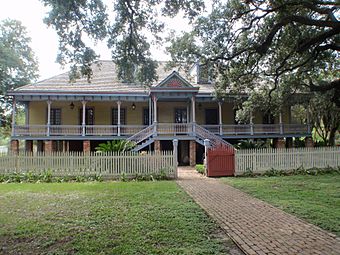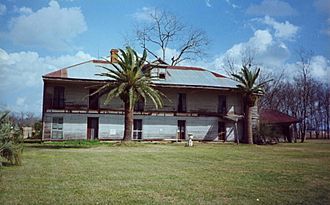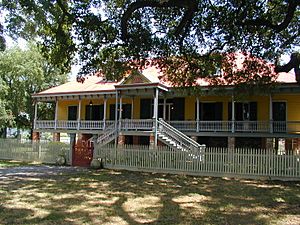Laura Plantation facts for kids
Quick facts for kids |
|
|
Laura Plantation
|
|

Laura Plantation house in 2011 after restoration
|
|
| Lua error in Module:Location_map at line 420: attempt to index field 'wikibase' (a nil value). | |
| Nearest city | Vacherie, Louisiana |
|---|---|
| Area | 37 acres (15 ha) |
| Built | 1805 |
| Architectural style | Creole |
| Website | Laura Plantation |
| MPS | Louisiana's French Creole architecture MPS |
| NRHP reference No. | 92001842 |
| Added to NRHP | February 3, 1993 |
Laura Plantation is a historic home located on the west bank of the Mississippi River in Vacherie, Louisiana. It's a great example of a Louisiana Creole plantation that has been carefully restored.
This plantation was once known as Duparc Plantation. It's special because it has a unique "Créole-style" main house from the early 1800s. It also has several other buildings that are still standing, including two original cabins where enslaved people lived.
Laura Plantation is one of only 15 plantation sites in Louisiana that still has so many of its original buildings. Because of its important history, it is listed on the National Register of Historic Places. It's also part of the Louisiana African American Heritage Trail.
Did you know that Alcée Fortier, a professor who studied languages and folklore, collected Louisiana Creole versions of the famous Br'er Rabbit stories here in the 1870s? Also, the family of famous U.S. singer-songwriter Fats Domino once lived on this plantation.
Contents
History of Laura Plantation
Early Days and Land Grants
Long ago, in the early 1700s, a large village of the Acolapissa people was located here. They called it Tabiscanja, which means "long river view." This village was on high ground above the Mississippi River. Later, in 1785, Acadian refugees settled in this same area.
In 1804, a Frenchman named Guillaume Duparc, who had fought in the American Revolutionary War, asked then-President Thomas Jefferson for land. Jefferson wanted Duparc to be loyal to the U.S. after the Louisiana Purchase. So, he gave Duparc land along the Mississippi River. The Acolapissa people continued to live on the back part of the plantation until 1915.
Building the Plantation
Duparc's enslaved workers built his main house between 1804 and 1805. The house was shaped like a "U," with two wings around a central courtyard. A separate kitchen building was placed behind the main house. This kept the main house safer from fires and cooler in the summer.
Over time, the Duparc family bought more land. The sugarcane plantation grew to be very large. The main house and other buildings have changed over the years since 1805.
The sugar mill was about 1 mile (1.6 km) behind the main house, surrounded by sugarcane fields. A long dirt road stretched 3.5 miles (5.6 km) behind the house. This road was lined with cabins where the enslaved workers lived.
Before the American Civil War, the area where enslaved people lived included a small hospital. There were 69 cabins, shared kitchens, and several water wells along the road. Each cabin was home to two families. They had separate doors and shared a central fireplace. Near each cabin, they often had a small vegetable garden and kept chickens or pigs. By the time of the Civil War, 186 enslaved people worked on the farm. The plantation grew and sold crops like indigo, rice, pecans, and sugarcane.
The plantation continued to operate into the 20th century. Over time, parts of the main house were changed. The two back wings were removed, and a kitchen wing was added to the back porch. Today, the plantation includes the "big house" and several other buildings. These include six original cabins where enslaved people lived. There's also a maison de reprise, which is a second house. The fact that the original cabins are still there, and that farm workers lived in them until 1977, makes the site very important historically.
Architecture and Design
The Main House
The main house at Laura Plantation is almost hidden from the road by large oak trees. It was built in 1804–1805. The house has a raised brick basement and an upper floor made with bricks between wooden posts. Many parts of the house were built off-site and then put together, like a giant puzzle. This type of house is called a "Créole raised house," and there are only about 30 of them left in Louisiana.
Inside, the house has two rows of five rooms. All the rooms open into each other, so there are no hallways. The house is filled with original old furniture. Some pieces were given to the plantation by the families who used to own it. Some areas inside the house have been left unrestored. This helps visitors see how the walls were built long ago.
Family Life and Stories
You can see many family treasures and old clothes on display. These items help you imagine what daily life was like. Much of what we know about Laura Plantation comes from a book called Memories of the Old Plantation Home. This book was written by Laura Locoul Gore, who was born in the main house. The gift shop at the plantation also has books about the area.
The Fire of 2004
On August 9, 2004, a fire caused by electricity badly damaged the plantation house. About 80% of the house was destroyed, including the kitchen wing behind it. The left side of the house survived, but the right side's foundation was burned.
Restoration work began and was finished in 2006, even with Hurricane Katrina causing delays in 2005. The ashes of the kitchen wing were cleared away, but it was not rebuilt. Instead, the back corners of the house were covered with old gray boards. This shows where the two back wings of the house used to be when Laura Locoul sold the plantation in 1891.
People of Laura Plantation
The Duparc and Locoul Families
The first owner, Guillaume Benjamin Demézière Duparc, lived at the plantation for four years. He died in 1808, just three years after the house was finished. His daughter, Elisabeth, married into the Locoul family. Many years later, Laura Locoul Gore, who was born in the main house in 1861, inherited the plantation. She had married and moved to New Orleans. Her book, Memories of the Old Plantation Home, was published after her death in 2000.
After inheriting the plantation, Laura Locoul Gore became its fourth female owner. She managed the plantation as a sugarcane business until 1891. Then, she sold it to Aubert Florian Waguespack. The Waguespack family lived and worked on the plantation for almost another century, until 1984.
The Br'er Rabbit Stories
The famous Brer Rabbit and Br'er Fox stories told in Louisiana and the South come from traditional tales. These stories started in Senegal, Africa. Enslaved Senegalese people brought them to America around the 1720s as part of their culture.
According to the plantation's history, Alcée Fortier, a neighbor and folklore student, visited in the 1870s. He listened to the freedmen (formerly enslaved people) tell stories to their children. These stories were in the Louisiana Creole language, which developed from French and African languages. The tales were about Compair Lapin (the clever rabbit) and Compair Bouki (the stupid fool), where the rabbit often played tricks.
In 1894, Fortier published these stories in a book called Louisiana Folk Tales: In French Dialect and English Translation. He may have collected some of these tales at Laura Plantation and his own family's plantation.
In the late 1900s, the connection between Laura Plantation and Fortier's Br'er Rabbit tales caught the attention of Norman Marmillion, who wanted to save old buildings. He started a company to get investors to help restore the plantation. Some of these investors are descendants of the original owners.
See also
- Whitney Plantation
- Rural African American Museum, Opelousas
- List of plantations in Louisiana
- National Register of Historic Places listings in St. James Parish, Louisiana





